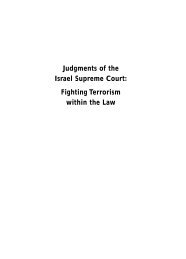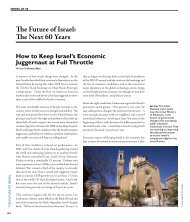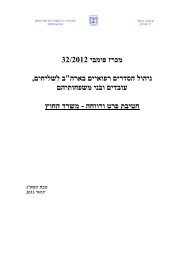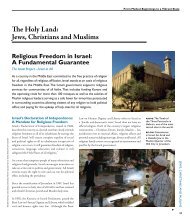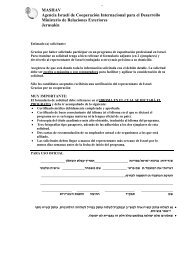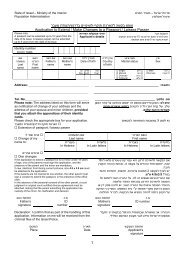Judgments of the Israel Supreme Court: Fighting Terrorism within ...
Judgments of the Israel Supreme Court: Fighting Terrorism within ...
Judgments of the Israel Supreme Court: Fighting Terrorism within ...
You also want an ePaper? Increase the reach of your titles
YUMPU automatically turns print PDFs into web optimized ePapers that Google loves.
<strong>the</strong> route <strong>of</strong> <strong>the</strong> fence and not <strong>the</strong> authority to erect it. After reaching this<br />
conclusion, we must now contend with <strong>the</strong> second question before us – <strong>the</strong><br />
question that constituted <strong>the</strong> main part <strong>of</strong> <strong>the</strong> arguments before us. This<br />
question is <strong>the</strong> legality <strong>of</strong> <strong>the</strong> location and route <strong>of</strong> <strong>the</strong> separation fence. We<br />
will now turn to this question.<br />
The Route <strong>of</strong> <strong>the</strong> Separation Fence<br />
33. The focus <strong>of</strong> this petition is <strong>the</strong> legality <strong>of</strong> <strong>the</strong> route chosen for<br />
construction <strong>of</strong> <strong>the</strong> separation fence. This question stands on its own, and<br />
it requires a straightforward, real answer. It is insufficient that <strong>the</strong> fence be<br />
motivated by security considerations, as opposed to political considerations.<br />
The military commander is not at liberty to pursue, in <strong>the</strong> area held by him<br />
in belligerent occupation, every activity which is primarily motivated<br />
by security considerations. The discretion <strong>of</strong> <strong>the</strong> military commander is<br />
restricted by <strong>the</strong> normative system in which he acts, and which is <strong>the</strong> source<br />
<strong>of</strong> his authority. Indeed, <strong>the</strong> military commander is not <strong>the</strong> sovereign in<br />
<strong>the</strong> occupied territory. See Oppenheim, The Legal Relations Between an<br />
Occupying Power and <strong>the</strong> Inhabitants, 33 Law Q. Rev., 363, 364 (1917);<br />
Y. Dinstein, The Law <strong>of</strong> War 210 (1983). He must act <strong>within</strong> <strong>the</strong> law which<br />
grants his authority in a situation <strong>of</strong> belligerent occupation. What is <strong>the</strong><br />
content <strong>of</strong> this law?<br />
34. The law <strong>of</strong> belligerent occupation recognizes <strong>the</strong> authority <strong>of</strong> <strong>the</strong><br />
military commander to maintain security in <strong>the</strong> area and to protect <strong>the</strong> security<br />
<strong>of</strong> his country and its citizens. However, it imposes conditions on <strong>the</strong> use <strong>of</strong><br />
this authority. This authority must be properly balanced against <strong>the</strong> rights,<br />
needs, and interests <strong>of</strong> <strong>the</strong> local population:<br />
The law <strong>of</strong> war usually creates a delicate balance between two poles: military<br />
necessity on one hand, and humanitarian considerations on <strong>the</strong> o<strong>the</strong>r.<br />
Dinstein, Legislative Authority in <strong>the</strong> Administered Territories, 2 Iyunei<br />
Mishpat 505, 509 (1973)<br />
This <strong>Court</strong> has emphasized, in case law dating back to <strong>the</strong> Six Day War,<br />
that “toge<strong>the</strong>r with <strong>the</strong> right to administer comes <strong>the</strong> obligation to provide<br />
for <strong>the</strong> well being <strong>of</strong> <strong>the</strong> population.” HCJ 337/71 Al-jamaya Al-masihiye<br />
L’alararchi Elmakdasa v. Minister <strong>of</strong> Defense, at 581 (Sussman, D.P.).<br />
30




